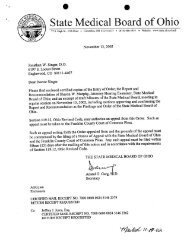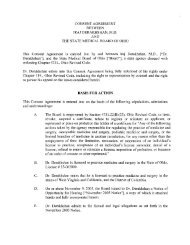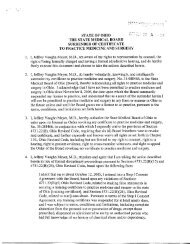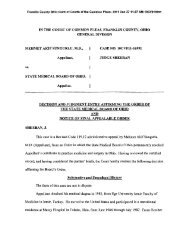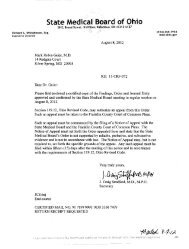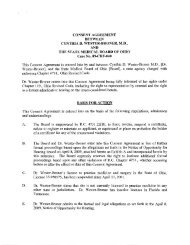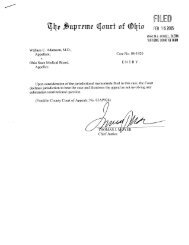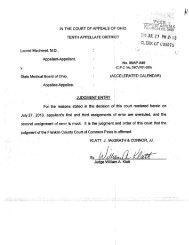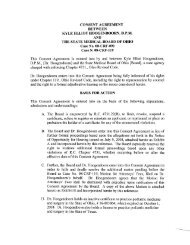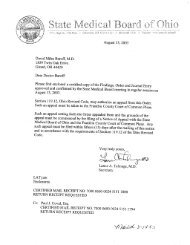Untitled - State Medical Board of Ohio - State of Ohio
Untitled - State Medical Board of Ohio - State of Ohio
Untitled - State Medical Board of Ohio - State of Ohio
You also want an ePaper? Increase the reach of your titles
YUMPU automatically turns print PDFs into web optimized ePapers that Google loves.
Report and Recommendation<br />
In the Matter <strong>of</strong> Ahmad Hosseinipour, M.D.<br />
Page 2<br />
The <strong>Board</strong> alleged that Dr. Hosseinipour’s acts, conduct, and/or omissions<br />
constituted “‘the violation <strong>of</strong> any provision <strong>of</strong> a code <strong>of</strong> ethics...<strong>of</strong> a<br />
national pr<strong>of</strong>essional organization,’ as that clause is used in Section<br />
4731.22(B)(28)(a), <strong>Ohio</strong> Revised Code, to wit: Principles III and/or IV <strong>of</strong><br />
the American <strong>Medical</strong> Association’s Principles <strong>of</strong> <strong>Medical</strong> Ethics.”<br />
Further, the <strong>Board</strong> alleged that Dr. Hosseinipour’s acts, conduct and/or<br />
omissions constituted the “[i]nability to practice according to acceptable<br />
and prevailing standards <strong>of</strong> care by reason <strong>of</strong> mental illness or physical<br />
illness, including, but not limited to, physical deterioration that adversely<br />
affects cognitive, motor, or perceptive skills,’ as that clause is used in<br />
Section 4731.22(B)(19), <strong>Ohio</strong> Revised Code.”<br />
The <strong>Board</strong> further advised Dr. Hosseinipour that he was entitled to a<br />
hearing on these matters. (<strong>State</strong>’s Exhibit 1)<br />
B. On August 8, 1997, Dr. Hosseinipour submitted a written hearing request<br />
with the <strong>Board</strong>. (<strong>State</strong>’s Exhibit 3)<br />
II. Appearances<br />
A. On behalf <strong>of</strong> the <strong>State</strong> <strong>of</strong> <strong>Ohio</strong>: Betty D. Montgomery, Attorney General,<br />
by James McGovern, Assistant Attorney General.<br />
B. On behalf <strong>of</strong> the Respondent: The Hearing Examiner apprised<br />
Dr. Hosseinipour <strong>of</strong> his right to be represented by counsel, nevertheless<br />
he appeared on his own behalf.<br />
I. Testimony Heard<br />
A. Presented by the <strong>State</strong><br />
EVIDENCE EXAMINED<br />
1. Martin Macklin, M.D., Ph.D.<br />
2. Ahmad Hosseinipour, M.D., as if up on cross-examination<br />
3. Gene Alan Butcher, M.D.<br />
4. James P. Evans<br />
5. Thomas Carchedi<br />
6. Terry Keith Martin
Report and Recommendation<br />
In the Matter <strong>of</strong> Ahmad Hosseinipour, M.D.<br />
Page 3<br />
B. Presented by Respondent<br />
1. Catherine Easton<br />
2. Charles E. Wilkins, M.D.<br />
3. Larry Kline<br />
4. Ahmad Hosseinipour, M.D.<br />
II. Exhibits Examined<br />
In addition to <strong>State</strong>’s Exhibits 2 and 3, noted above, the following exhibits were<br />
identified and admitted into evidence:<br />
A. Presented by the <strong>State</strong><br />
1. <strong>State</strong>’s Exhibit 1: Copy <strong>of</strong> January 27, 1997, letter to Dr. Hosseinipour<br />
from the <strong>Board</strong>. (6 pp.)<br />
2. <strong>State</strong>’s Exhibit 4: Copy <strong>of</strong> August 25, 1997, letter to Dr. Hosseinipour<br />
from the <strong>Board</strong> advising that a hearing had been set for September 3,<br />
1997, but further advising that the hearing had been postponed<br />
pursuant to Section 119.09, <strong>Ohio</strong> Revised Code. (2 pp.)<br />
3. <strong>State</strong>’s Exhibit 5: Copy <strong>of</strong> August 27, 1997, letter to Dr. Hosseinipour<br />
from the <strong>Board</strong> scheduling the hearing for September 30, 1997. (2 pp.)<br />
4. <strong>State</strong>’s Exhibit 6: Copy <strong>of</strong> September 23, 1997, Entry reassigning<br />
this matter to Suzanne E. Kelly, Attorney Hearing Examiner.<br />
5. <strong>State</strong>’s Exhibit 7: Copy <strong>of</strong> September 25, 1997, <strong>State</strong>’s Motion for<br />
Continuance. (8 pp.).<br />
6. <strong>State</strong>’s Exhibit 8: Copy <strong>of</strong> September 26, 1997, Entry granting the<br />
<strong>State</strong>’s Motion for Continuance.<br />
7. <strong>State</strong>’s Exhibit 9: Copy <strong>of</strong> October 28, 1997, Respondent’s Motion for<br />
Continuance. (2 pp.)<br />
8. <strong>State</strong>’s Exhibit 10: Copy <strong>of</strong> October 29, 1997, Entry granting<br />
Respondent’s Motion for Continuance and rescheduling the hearing<br />
for December 1 and 2, 1997.
Report and Recommendation<br />
In the Matter <strong>of</strong> Ahmad Hosseinipour, M.D.<br />
Page 4<br />
9. <strong>State</strong>’s Exhibit 11: Curriculum vitae <strong>of</strong> Martin Macklin, M.D., Ph.D.<br />
(4 pp.)<br />
10. <strong>State</strong>’s Exhibit 12: Copy <strong>of</strong> January 27, 1997, letter to Dr. Macklin<br />
from the <strong>Board</strong>. (2 pp.)<br />
11. <strong>State</strong>’s Exhibit 13: Copy <strong>of</strong> April 8, 1997, letter to Dr. Macklin from<br />
the <strong>Board</strong>. (19 pp.)<br />
12. <strong>State</strong>’s Exhibit 14: Copy <strong>of</strong> April 24, 1997, report <strong>of</strong> Dr. Macklin<br />
regarding Dr. Hosseinipour. (6 pp.)<br />
13. <strong>State</strong>’s Exhibit 15: Copy <strong>of</strong> June 25, 1997, facsimile transmission to<br />
Dr. Macklin from the <strong>Board</strong>. (3 pp.)<br />
14. <strong>State</strong>’s Exhibit 16: Copy <strong>of</strong> June 25, 1997, letter to the <strong>Board</strong> from<br />
Dr. Macklin. (3 pp.)<br />
15. <strong>State</strong>’s Exhibit 17: Copy <strong>of</strong> February 27, 1995, open letter <strong>of</strong><br />
resignation from Dr. Hosseinipour.<br />
16. <strong>State</strong>’s Exhibit 18: Copy <strong>of</strong> August 30, 1995, open letter from<br />
Dr. Hosseinipour regarding perceived problems with the residency<br />
program at Western Reserve Care System [WRCS]. ( 2 pp.)<br />
17. <strong>State</strong>’s Exhibit 20: Copy <strong>of</strong> May 2, 1995, letter to Dr. Hosseinipour<br />
from Harvey Eisenberg, M.D., Chairman and Pr<strong>of</strong>essor <strong>of</strong> WRCS,<br />
Department <strong>of</strong> Internal Medicine.<br />
18. <strong>State</strong>’s Exhibit 21: Copy <strong>of</strong> October 26, 1995, Decision <strong>of</strong> the <strong>State</strong> <strong>of</strong><br />
<strong>Ohio</strong> Unemployment Compensation <strong>Board</strong> <strong>of</strong> Review regarding the<br />
claim <strong>of</strong> Dr. Hosseinipour against WRCS. (5 pp.)<br />
19. <strong>State</strong>’s Exhibit 22: Copy <strong>of</strong> November 30, 1995, letter to<br />
Dr. Hosseinipour from Gene A. Butcher, M.D., Senior Vice<br />
President, <strong>Medical</strong> and Academic Affairs, WRCS.<br />
20. <strong>State</strong>’s Exhibit 23: Copy <strong>of</strong> July 6, 1995, Incident Report from WRCS<br />
regarding Dr. Hosseinipour.<br />
21. <strong>State</strong>’s Exhibit 24: Copy <strong>of</strong> undated Incident Report from Security<br />
Manager Thomas Carchedi. (2 pp.)
Report and Recommendation<br />
In the Matter <strong>of</strong> Ahmad Hosseinipour, M.D.<br />
Page 5<br />
22. <strong>State</strong>’s Exhibit 25: Copy <strong>of</strong> August 14, 1995, Incident Report from<br />
WRCS regarding Dr. Hosseinipour.<br />
23. <strong>State</strong>’s Exhibit 26: Copy <strong>of</strong> January 21, 1997, Memorandum to Jim<br />
Evans from Tom Carchedi regarding Dr. Hosseinipour. (2 pp.)<br />
24. <strong>State</strong>’s Exhibit 27: Copy <strong>of</strong> September 1, 1995, letter to<br />
Dr. Hosseinipour from Maria R. Schimer, General Counsel for<br />
Northeastern <strong>Ohio</strong> University College <strong>of</strong> Medicine [NEOUCOM].<br />
25. <strong>State</strong>’s Exhibit 28: Copy <strong>of</strong> November 17, 1995, Incident Report from<br />
WRCS regarding Dr. Hosseinipour. (2 pp.)<br />
26. <strong>State</strong>’s Exhibit 29: Copy <strong>of</strong> November 30, 1995, letter to Martin<br />
Hume, Esq., from James P. Evans, Esq., WRCS Vice President &<br />
General Counsel, regarding Dr. Hosseinipour.<br />
27. <strong>State</strong>’s Exhibit 30: Copy <strong>of</strong> January 25, 1996, WRCS memorandum<br />
to Jim Evans from Betty Davies regarding Dr. Hosseinipour.<br />
28. <strong>State</strong>’s Exhibit 31: Copy <strong>of</strong> January 25, 1996, Incident Report from<br />
WCRS regarding Dr. Hosseinipour. (2 pp.)<br />
29. <strong>State</strong>’s Exhibit 32: Copy <strong>of</strong> January 26, 1996, crime report to<br />
Youngstown Police Department regarding Dr. Hosseinipour.<br />
30. <strong>State</strong>’s Exhibit 33: Copy <strong>of</strong> April 26, 1996, letter to Dennis Sarisky,<br />
Esq. from Mr. Evans regarding Dr. Hosseinipour. (3 pp.)<br />
31. <strong>State</strong>’s Exhibit 34: Copy <strong>of</strong> June 16, 1996, letter to Dr. Hosseinipour<br />
from Mr. Evans.<br />
32. <strong>State</strong>’s Exhibit 35: Copy <strong>of</strong> November 1, 1996, letter to Dr. Hosseinipour<br />
from Mr. Evans.<br />
33. <strong>State</strong>’s Exhibit 36: Copy <strong>of</strong> November 4, 1996, memorandum to<br />
Mr. Carchedi from Dr. Butcher regarding telephone calls from<br />
Dr. Hosseinipour. (2 pp.)<br />
34. <strong>State</strong>’s Exhibit 37: Copy <strong>of</strong> November 5, 1996, Incident Report<br />
Supplement regarding telephone harassment by Dr. Hosseinipour.
Report and Recommendation<br />
In the Matter <strong>of</strong> Ahmad Hosseinipour, M.D.<br />
Page 6<br />
35. <strong>State</strong>’s Exhibit 38: Copy <strong>of</strong> December 19, 1996, Incident Report from<br />
WRCS regarding Dr. Hosseinipour. (3 pp.)<br />
36. <strong>State</strong>’s Exhibit 39: Certified copies <strong>of</strong> complaint and disposition in<br />
Case Nos. 95-CR-2234, 96-CR-116, Municipal Court <strong>of</strong> the City <strong>of</strong><br />
Youngstown, Mahoning County, <strong>Ohio</strong>. (7 pp.)<br />
37. <strong>State</strong>’s Exhibit 40: Certified copies <strong>of</strong> complaint and disposition in<br />
Case Nos. 96-CR-116 and 96-CR-117. (11 pp.)<br />
38. <strong>State</strong>’s Exhibit 41: Copy <strong>of</strong> mitigation evaluation <strong>of</strong> Dr. Hosseinipour<br />
by the Forensic Psychiatric Center <strong>of</strong> Northeast, <strong>Ohio</strong>, Inc. (5 pp.)<br />
39. <strong>State</strong>’s Exhibit 42: Copy <strong>of</strong> April 14, 1996, <strong>Ohio</strong> Uniform Incident<br />
Report, Liberty Police Department. (9 pp.)<br />
40. <strong>State</strong>’s Exhibit 43: Certified copy <strong>of</strong> case docket for Case Nos. 96-<br />
CRB-315A and 96-CRB-315B. (2 pp.)<br />
41. <strong>State</strong>’s Exhibit 44: Copy <strong>of</strong> Sheriff’s Department Trumbull County,<br />
<strong>Ohio</strong>, Incident Report, regarding Dr. Hosseinipour. (4 pp.)<br />
42. <strong>State</strong>’s Exhibit 45: Certified copy <strong>of</strong> case report for Criminal Case<br />
No. 97-CRB01032-01. (3 pp.)<br />
B. Presented by the Respondent<br />
1. Respondent’s Exhibit A: Copy <strong>of</strong> Dr. Hosseinipour’s medical records as<br />
kept by Anil Nalluri, M.D. (14 pp.) (Sealed to protect confidentiality)<br />
2. Respondent’s Exhibit B: Dr. Hosseinipour’s curriculum vitae. (2 pp.)<br />
3. Respondent’s Exhibit C: Copy <strong>of</strong> April 15, 1997, letter to Thomas<br />
Marnejon, D.O. from Paul D. Bunn, M.D. (2 pp.)<br />
4. Respondent’s Exhibit D: Copy <strong>of</strong> October 22, 1996, letter to Evelyn<br />
Pintz, M.D., from Charles E. Wilkins, M.D.<br />
5. Respondent’s Exhibit E: Pr<strong>of</strong>fered (see Procedural Matters).
Report and Recommendation<br />
In the Matter <strong>of</strong> Ahmad Hosseinipour, M.D.<br />
Page 7<br />
6. Respondent’s Exhibit F: Copy <strong>of</strong> April 15, 1994, open letter from<br />
Harvey Eisenberg, M.D., Chairman, Dept. <strong>of</strong> Internal Medicine,<br />
WRCS.<br />
7. Respondent’s Exhibit G: Copy <strong>of</strong> March 30, 1993, letter to<br />
Lawrence M. Pass, M.D., from Janine L. Janowicz, M.D.<br />
8. Respondent’s Exhibit H: Copy <strong>of</strong> December 10, 1996, letter to<br />
Dr. Hosseinipour from Ronald Edwards, Warden, Ross Correctional<br />
Institution.<br />
9. Respondent’s Exhibit I: Copy <strong>of</strong> certificates <strong>of</strong> recommendation for<br />
Dr. Hosseinipour that he submitted with his application for <strong>Ohio</strong><br />
licensure. (7 pp.)<br />
10. Respondent’s Exhibit J: Copy <strong>of</strong> August 9, 1994, open letter from L.<br />
Kevin Nash, M.D. regarding Dr. Hosseinipour.<br />
11. Respondent’s Exhibit K: Copy <strong>of</strong> February 13, 1997, open letter from<br />
Dr. Hosseinipour. (3 pp.)<br />
12. Respondent’s Exhibit L: Copy <strong>of</strong> certificates from various<br />
educational activities completed by Dr. Hosseinipour. (13 pp.)<br />
13. Respondent’s Exhibit M: Copy <strong>of</strong> October 13, 1994, letter to<br />
Dr. Eisenberg from Dr. Hosseinipour regarding his schedule and<br />
subspecialty rotations.<br />
14. Respondent’s Exhibit N: Copy <strong>of</strong> January 15, 1996, letter to<br />
Mr. Hume from William E. Rodak, Accreditation Council for<br />
Graduate <strong>Medical</strong> Education.<br />
15. Respondent’s Exhibit O: Copy <strong>of</strong> March 25, 1996, letter to Mr. Hume<br />
from Robert Ballard. (2 pp.)<br />
16. Respondent’s Exhibit P: Copy <strong>of</strong> December 8, 1995, letter to Muriel<br />
Horne from Dr. Hosseinipour.<br />
17. Respondent’s Exhibit Q: Pr<strong>of</strong>fered (see Procedural Matters)<br />
18. Respondent’s Exhibit R: Copy <strong>of</strong> evaluations <strong>of</strong> Dr. Hosseinipour.<br />
(5 pp.)
Report and Recommendation<br />
In the Matter <strong>of</strong> Ahmad Hosseinipour, M.D.<br />
Page 8<br />
19. Respondent’s Exhibit S: Copy <strong>of</strong> April 26, 1995, letter to Dr. Bunn<br />
from Kathleen Padgitt, M.D.<br />
20. Respondent’s Exhibit T: Copy <strong>of</strong> Appendix A, “Due Process for<br />
Residents.” (2 pp.)<br />
21. Respondent’s Exhibit U: Copies <strong>of</strong> January 1992 letters <strong>of</strong><br />
recommendation for Dr. Hosseinipour from various physicians.<br />
(3 pp.)<br />
22. Respondent’s Exhibit V: Copy <strong>of</strong> December 15, 1994, memorandum<br />
to Dr. Eisenberg and Dr. Padgitt.<br />
23. Respondent’s Exhibit W: Copy <strong>of</strong> August 18, 1994, Clinical<br />
Evaluation Exercise <strong>of</strong> Dr. Hosseinipour. (4 pp.)<br />
24. Respondent’s Exhibit X: Copy <strong>of</strong> WRCS Department <strong>of</strong> Internal<br />
Medicine Southside On-Call Schedule from September 1994 through<br />
May 1995, excluding the months <strong>of</strong> July, August and October. (8 pp.)<br />
25. Respondent’s Exhibit Y: Copy <strong>of</strong> “Program Requirements for<br />
Residency Education in Internal Medicine.” (20 pp.)<br />
26. Respondent’s Exhibit Z: Copy <strong>of</strong> Resident Agreement between<br />
Western Reserve Care System and Dr. Hosseinipour. (3 pp.)<br />
C. Joint Exhibits<br />
Joint Exhibit 1: Copy <strong>of</strong> Transcript from the Due Process Hearing <strong>of</strong><br />
Dr. Hosseinipour, held November 7, 1995, at WRCS. (104 pp.)<br />
PROCEDURAL MATTERS<br />
1. The Assistant Attorney General objected to Respondent’s Exhibits E and Q due<br />
to the absence <strong>of</strong> the authors’ signatures. The Hearing Examiner’s attempts to<br />
obtain signed copies <strong>of</strong> these documents were unsuccessful. Accordingly,<br />
Respondent’s Exhibits E and Q are not admitted, but are pr<strong>of</strong>fered for appeal<br />
purposes.
Report and Recommendation<br />
In the Matter <strong>of</strong> Ahmad Hosseinipour, M.D.<br />
Page 9<br />
2. Although Dr. Macklin testified as to the content <strong>of</strong> the American <strong>Medical</strong><br />
Association’s Principles <strong>of</strong> <strong>Medical</strong> Ethics, the <strong>State</strong> did not submit a copy <strong>of</strong><br />
these Principles. Upon motion <strong>of</strong> the Hearing Examiner, a copy <strong>of</strong> the AMA’s<br />
Principles <strong>of</strong> <strong>Medical</strong> Ethics is included as <strong>Board</strong> Exhibit 1.<br />
SUMMARY OF THE EVIDENCE<br />
All exhibits and transcripts <strong>of</strong> testimony, even if not specifically mentioned, were<br />
thoroughly reviewed and considered by the Hearing Examiner prior to preparing<br />
this Report and Recommendation.<br />
1. Ahmad Hosseinipour, M.D., came to the United <strong>State</strong>s from Iran in 1975.<br />
Dr. Hosseinipour earned his civil engineering degree in December 1978 from<br />
Purdue University. Dr. Hosseinipour continued his studies at Purdue, earning<br />
his Master’s Degree in May 1981. Although Dr. Hosseinipour began his Ph.D.<br />
in civil engineering, he did not complete it. Instead, Dr. Hosseinipour entered<br />
medical school in the Phillipines. Dr. Hosseinipour earned his medical degree<br />
in 1987 from Southwestern University in the Phillipines. (Respondent’s<br />
Exhibit [Res.Ex.] B; Tr. 59-63)<br />
In 1989, Dr. Hosseinipour returned to the United <strong>State</strong>s and spent a year at<br />
Indiana University studying physiology. In 1991, Dr. Hosseinipour began but<br />
did not complete a transitional residency in Newark, New Jersey.<br />
Dr. Hosseinipour testified that he left the residency due to his inadequate level<br />
<strong>of</strong> medical knowledge. (Res. Ex. B, I, L; Tr. 64)<br />
2. In March 1992, Dr. Hosseinipour entered a subinternship in Canton, <strong>Ohio</strong>, to<br />
remedy his knowledge deficiency. From July 1992 through June 1993, he<br />
completed his one year internal medicine internship, at Aultman and Timken<br />
Hospital in Canton, <strong>Ohio</strong>. Upon the recommendation <strong>of</strong> his program director,<br />
Dr. Hosseinipour moved to the Western Reserve Care System [WRCS] in<br />
Youngstown, <strong>Ohio</strong>, to begin his post-graduate residency program year two<br />
[PGY-II]. (Res. Ex. B, G, L; Tr. 65-68)<br />
3. Gene Alan Butcher, M.D. testified that he currently holds the position <strong>of</strong> senior<br />
vice-president for medical and academic affairs at WRCS. As part <strong>of</strong> his<br />
position, Dr. Butcher oversees the residency programs and serves as an<br />
advocate for the residents at WRCS. Dr. Butcher met Dr. Hosseinipour when<br />
Dr. Hosseinipour began his PGY-II at WRCS. Dr. Butcher testified that the<br />
faculty <strong>of</strong> WRCS had expressed concern about Dr. Hosseinipour’s interpersonal
Report and Recommendation<br />
In the Matter <strong>of</strong> Ahmad Hosseinipour, M.D.<br />
Page 10<br />
relations and his medical knowledge. However, Dr. Hosseinipour received a<br />
standard contract for his PGY-III year. (Res. Ex. Z; Tr. 68, 196-201)<br />
4. Dr. Butcher testified that Dr. Hosseinipour expressed several concerns to him<br />
during his PGY-III year. These concerns included the amount <strong>of</strong> time<br />
Dr. Hosseinipour spent on the ward, his inability to moonlight, the frequency <strong>of</strong><br />
his call schedule, and concerns about faculty and the new program director,<br />
Dr. Eisenberg. (St. Ex. 13; Res. Ex. K, M-P; Tr. 79-87, 201-210) As a result <strong>of</strong><br />
these concerns, Dr. Hosseinipour submitted a one line resignation letter in<br />
February 1995. (St. Ex. 17) Dr. Butcher investigated Dr. Hosseinipour’s<br />
claims and found no basis for them. However, Dr. Butcher elected not to act<br />
immediately on Dr. Hosseinipour’s resignation. (Tr. 209-211)<br />
5. In the spring <strong>of</strong> 1995, Dr. Hosseinipour received permission and funds from the<br />
WRCS Internal Medicine Department to attend a board review class in<br />
Cincinnati, <strong>Ohio</strong>. In April 1995, Dr. Hosseinipour received notice that his<br />
permission to attend the conference had been rescinded. Dr. Hosseinipour<br />
testified that he was told that he had to remain at WRCS to attend to his<br />
patients. (Tr. 89-93)<br />
Despite this, Dr. Hosseinipour attended the Cincinnati board review seminar<br />
during the first week <strong>of</strong> May 1995. While at the conference, Dr. Hosseinipour<br />
contacted WRCS to inform them <strong>of</strong> his whereabouts. Dr. Hosseinipour<br />
explained that he was depressed and needed to get away. Dr. Hosseinipour’s<br />
chief resident informed him that he should not have gone, but did not tell him<br />
to return.<br />
Following the Cincinnati conference, Dr. Hosseinipour went to a conference at<br />
Northeastern <strong>Ohio</strong> College <strong>of</strong> Medicine [NEOUCOM] in Rootstown. In<br />
response to a page from WRCS, Dr. Hosseinipour returned and met with Drs.<br />
Eisenberg and Bunn. Dr. Butcher accepted Dr. Hosseinipour’s previously<br />
tendered resignation as a result <strong>of</strong> this unexcused absence, Dr. Hosseinipour<br />
testified that he had told Dr. Butcher to tear up his February resignation<br />
shortly after he submitted it. (St. Ex. 20; Tr. 90-100)<br />
6. On July 6, 1995, Dr. Hosseinipour went to the Northside campus <strong>of</strong> the WRCS.<br />
Security asked him to leave. Later that same day, Dr. Hosseinipour went to<br />
the Southside Campus <strong>of</strong> the WRCS. Again, security <strong>of</strong>ficers asked him to<br />
leave and not return. (St. Ex. 23; Tr. 284-286, 311-312)<br />
7. On August 3, 1995, Dr. Hosseinipour visited Liberty Firearms. After reviewing<br />
the inventory <strong>of</strong> weapons, Dr. Hosseinipour asked a store employee how to
Report and Recommendation<br />
In the Matter <strong>of</strong> Ahmad Hosseinipour, M.D.<br />
Page 11<br />
purchase a gun and whether he could purchase a machine gun.<br />
Dr. Hosseinipour then inquired whether he could send arms to Iran.<br />
Dr. Hosseinipour testified that he was simply curious and “didn’t mean<br />
anything by it.” After the store employee informed Dr. Hosseinipour that it<br />
was illegal to send arms out <strong>of</strong> the country, Dr. Hosseinipour asked if he gave<br />
the employee $5,000.00, could the arms be shipped to Iran. The employee<br />
reiterated that it was illegal to send arms out <strong>of</strong> the country. Dr. Hosseinipour<br />
testified that he then left the store. However, the store employee reported to<br />
the Bureau <strong>of</strong> Alcohol Tobacco and Firearms that Dr. Hosseinipour also<br />
inquired about the availability <strong>of</strong> books and materials for the construction <strong>of</strong><br />
bombs. (St. Ex. 24; Tr. 110-116, Tr. 287-290)<br />
Subsequently, Dr. Hosseinipour spoke with agents from the Bureau <strong>of</strong> Alcohol,<br />
Tobacco, and Firearms. The agents searched his home in August. The agents<br />
found no guns or explosives. After the search, agents informed<br />
Dr. Hosseinipour <strong>of</strong> the laws regarding firearms. (St. Ex. 24; Tr. 115-116, 287-<br />
292, 312-314)<br />
8. On August 14, 1995, Dr. Hosseinipour again entered the property <strong>of</strong> WRCS.<br />
Security stopped him and informed Dr. Hosseinipour that if he continued to<br />
trespass on WRCS property, he would be arrested and charged. (St. Ex. 25;<br />
Tr. 117-118, 314-316)<br />
9. On August 21, 1995, Dr. Hosseinipour telephoned a Federal Bureau <strong>of</strong><br />
Investigation [FBI] agent. Dr. Hosseinipour had established a pattern <strong>of</strong><br />
calling a particular agent to discuss his problems with WRCS and alleged<br />
discrimination. During this conversation, Dr. Hosseinipour stated that he<br />
wanted to place a bomb in the <strong>Medical</strong> Education Building at the Northside<br />
<strong>Medical</strong> Center <strong>of</strong> WRCS. (Tr. 119-124) At hearing, Dr. Hosseinipour testified<br />
that:<br />
It might be some angry words I mentioned, but I really didn’t mean that....<br />
I say I’ll kill you, it means, you know, I need your help, I need your<br />
attention.” (Tr. 120-121)<br />
The [FBI] contacted security for WRCS regarding Dr. Hosseinipour’s threats<br />
and actions. (St. Ex. 24; Tr. 115-116, 287-292, 312-314)<br />
10. In August 1995, Dr. Hosseinipour went to the <strong>Ohio</strong> Bureau <strong>of</strong> Employment<br />
Services [OBES]to search for a job. Terry Martin, security manager for WRCS,<br />
testified that an <strong>of</strong>ficer from OBES contacted him regarding vague threats<br />
made by Dr. Hosseinipour. At hearing, Dr. Hosseinipour denied that he made
Report and Recommendation<br />
In the Matter <strong>of</strong> Ahmad Hosseinipour, M.D.<br />
Page 12<br />
any threatening remarks to the staff at OBES. “I believe this information<br />
came from the security <strong>of</strong> [WRCS], which they are everywhere I go. They<br />
contacted them...Terry Martin...sort <strong>of</strong> spied on me...” (Tr. 126-127; 313-314)<br />
11. On September 1, 1995, the Northeastern <strong>Ohio</strong> University College <strong>of</strong> Medicine<br />
[NEOUCOM] provided written notice to Dr. Hosseinipour that due to his<br />
recent harassing behavior and his lack <strong>of</strong> respect for security personnel, he was<br />
no longer permitted on the Rootstown campus <strong>of</strong> NEOUCOM. NEOUCOM did<br />
not detail the specific harassing behavior. Dr. Hosseinipour admitted that he<br />
had received this letter. (St. Ex. 27) However, subsequent to receiving this<br />
letter, Dr. Hosseinipour testified that he went to NEOUCOM to ask for help<br />
with his situation at WRCS. Dr. Hosseinipour also testified that he called the<br />
dean <strong>of</strong> NEOUCOM repeatedly. (Tr. 128-133)<br />
12. James P. Evans, the vice-president and general counsel for WRCS, reviewed<br />
the situation with Dr. Hosseinipour’s trespassing and telephone calls. He<br />
suggested a due process hearing as an opportunity for Dr. Hosseinipour to air<br />
his grievances in a public forum. WRCS provided a due process hearing to him<br />
on November 7, 1995. (St. Ex. 20; Joint Exhibit [Jt. Ex.] 1; Res. Ex. K, S, T, V,<br />
X Tr. 89-93, 102, 211-212) A resident from the pathology program, a faculty<br />
member <strong>of</strong> the family practice department, and the associate program director<br />
<strong>of</strong> the pediatrics program composed the panel. The panel heard testimony from<br />
Dr. Eisenberg, Dr. Hosseinipour, Dr. Butcher, Dr. Bunn, and Dr. Nash. On<br />
November 30, 1995, the panel upheld the decision <strong>of</strong> the Department <strong>of</strong><br />
Internal Medicine regarding Dr. Hosseinipour’s termination from the residency<br />
program. Although the staff <strong>of</strong> WRCS had hoped that Dr. Hosseinipour would<br />
stop calling after the hearing, his telephone calls and harassing behavior<br />
intensified. (St. Ex. 22; Jt. Ex. 1; Tr. 217-223, 257-268)<br />
Dr. Hosseinipour testified that in his opinion, the due process hearing panel<br />
was not fairly composed. (St. Ex. 20; Joint Exhibit [Jt. Ex.] 1; Res. Ex. K, S, T,<br />
V, X Tr. 89-93, 102, 211-212)<br />
13. On November 17, 1995, Dr. Hosseinipour went to the WRCS Northside campus<br />
to complete a class in advanced pediatric life support. At the end <strong>of</strong> the second<br />
day, Dr. Hosseinipour left the classes, went to restricted areas, and spoke to<br />
Dr. Butcher. WRCS security detained Dr. Hosseinipour and contacted the<br />
Youngstown Police Department who charged Dr. Hosseinipour with criminal<br />
trespassing. (St. Ex. 28, 29, 39; Tr. 133-140, 230-234, 262-265, 294-299)<br />
Dr. Hosseinipour testified that he had only been looking for his certificate <strong>of</strong><br />
completion. (Tr. 133-140)
Report and Recommendation<br />
In the Matter <strong>of</strong> Ahmad Hosseinipour, M.D.<br />
Page 13<br />
Subsequently, the Youngstown Municipal Court dismissed the charge against<br />
Dr. Hosseinipour after he agreed to refrain from coming on the premises <strong>of</strong><br />
WRCS. (St. Ex. 29 & 39; Tr. 138-143, 265-267) At hearing, Dr. Hosseinipour<br />
testified that he “did not take [the letter and arrest] seriously.” (Tr. 144-145)<br />
Dr. Hosseinipour testified that he continued to have contact with the<br />
individuals at WRCS, although the contact was mostly telephonic. (Tr. 145)<br />
Dr. Hosseinipour characterized his telephone calls as every other day.<br />
Dr. Hosseinipour admitted contacting multiple medical and administrative<br />
staff members. (Tr. 145-148)<br />
Mr. Evans testified that Dr. Hosseinipour began calling the staff <strong>of</strong> WRCS<br />
within the same week that the charges were dismissed. Repeated letters from<br />
Mr. Evans reminding Dr. Hosseinipour <strong>of</strong> his agreement did not stop the<br />
telephone calls. (St. Ex. 34, 35; Tr. 261-263)<br />
14. Dr. Hosseinipour admitted that on January 25, 1996, he contacted the<br />
secretary <strong>of</strong> Gary Kaatz, president <strong>of</strong> WRCS. (Tr. 147-149) When the<br />
secretary informed Dr. Hosseinipour that Mr. Kaatz was unavailable, he left<br />
the following message:<br />
This is going to be a disaster...it is very important that I talk with<br />
him...Kaatz, Dr. Eisenberg, and Dr. Butcher are my target...if he doesn’t<br />
call me back, justice will be served. (St. Ex. 30)<br />
Dr. Hosseinipour testified that he did not intend to threaten the individuals<br />
and that the secretary misinterpreted his message. (Tr. 149-151) Dr. Butcher<br />
testified that after he learned <strong>of</strong> Dr. Hosseinipour’s interactions with the<br />
Liberty Firearms, he began to take Dr. Hosseinipour’s threats seriously.<br />
Dr. Butcher testified that the secretaries and staff in the medical education<br />
building were “absolutely terrified.” (Tr. 234-239) As a result <strong>of</strong> the<br />
January 25, 1996, telephone call, Dr. Hosseinipour was charged with three<br />
criminal counts <strong>of</strong> aggravated menacing, violations <strong>of</strong> Section 2903.21(A), <strong>Ohio</strong><br />
Revised Code. Additionally, the previous charges <strong>of</strong> criminal trespassing was<br />
reinstated. (St. Ex. 31; Tr. 150-154, 316-320)<br />
On March 25, 1996, after plea negotiations, one count <strong>of</strong> aggravated menacing<br />
was reduced to disorderly conduct, the other two counts were dismissed.<br />
Dr. Hosseinipour pleaded no contest to criminal trespassing and disorderly<br />
conduct. The Court gave Dr. Hosseinipour a suspended sentence and placed<br />
him on probation. The terms <strong>of</strong> Dr. Hosseinipour’s probation required him to
Report and Recommendation<br />
In the Matter <strong>of</strong> Ahmad Hosseinipour, M.D.<br />
Page 14<br />
remain in counseling, to refrain from contact with any <strong>of</strong> the parties involved<br />
in the criminal charges, and to refrain from entering the land or premises <strong>of</strong><br />
WRCS, NEOUCOM, or St. Elizabeth Hospitals or clinics. (St. Ex. 39 & 40;<br />
Tr. 156-160)<br />
15. On April 12, 1996, Mr. Evans wrote a letter to Dr. Hosseinipour. The letter<br />
stated in pertinent part:<br />
I am writing in follow-up to your recent telephone calls to Dr. Butcher and<br />
me. Although we sympathize with your unfortunate situation and<br />
inability to find a job, we have no specific suggestions for you.... I need to<br />
remind you that you are not to call anyone associated with WRCS. This is<br />
a condition <strong>of</strong> your probation. You are only to call me if you have a<br />
legitimate purpose. The issues you raised have all been discussed before<br />
and are considered closed from WRCS’s perspective. If you continue to<br />
call, I will have no choice but to report this matter to the City Prosecutor.<br />
(St. Ex. 33)<br />
16. On April 14, 1996, the Liberty Police arrested Dr. Hosseinipour and charged<br />
him with domestic violence. Dr. Hosseinipour reportedly had physically<br />
assaulted his wife by striking her in the left shoulder, kicking her in the<br />
stomach, and threatening her with a large kitchen knife. (St. Ex. 42; Tr. 179-<br />
180)<br />
17. On April 26, 1996, Mr. Evans contacted the Youngstown City Prosecutor and<br />
informed him that, in addition to the telephone calls noted in the April 12,<br />
1996, letter, Dr. Hosseinipour had called Mr. Kaatz three times at his home.<br />
(St. Ex. 33)<br />
On May 8, 1996, the Youngstown Municipal Court issued a writ <strong>of</strong> capias for<br />
Dr. Hosseinipour for having violated the terms <strong>of</strong> his probation. After a<br />
probation violation hearing on June 4, 1996, the Youngstown Municipal Court<br />
returned Dr. Hosseinipour to probation status. (St. Ex. 39; Tr. 179-180)<br />
Additionally, on May 24, 1996, the Girard Municipal Court charged<br />
Dr. Hosseinipour with aggravated menacing and telephone harassment for<br />
additional calls he made to Dr. Pass. The charges were eventually dismissed<br />
because he agreed to stop calling Dr. Pass. (St. Ex. 40; Tr. 179-180)<br />
18. Dr. Hosseinipour continued to contact the staff at WRCS. (St. Ex. 34, 35, 36 &<br />
37; Tr. 299-301) The individuals that he called described the impact <strong>of</strong> the<br />
telephone calls:
Report and Recommendation<br />
In the Matter <strong>of</strong> Ahmad Hosseinipour, M.D.<br />
Page 15<br />
• Dr. Butcher testified that his conversations with Dr. Hosseinipour tended<br />
to be repetitious. In these calls, received at the <strong>of</strong>fice and at home,<br />
Dr. Hosseinipour complained that he had been wronged and pleaded for<br />
help. Dr. Hosseinipour also threatened Dr. Butcher. Dr. Butcher<br />
patiently repeated that WRCS would not allow Dr. Hosseinipour to<br />
return, that Dr. Hosseinipour should utilize the skills that he had to<br />
support his wife and child, and that he should work on his interpersonal<br />
skills to create opportunities for himself. These constant calls caused<br />
great fear among Dr. Butcher’s staff and family. (St. Ex. 36; Tr. 224-229,<br />
239-242)<br />
• Mr. Evans testified that he attempted to coordinate WRCS’ response to<br />
Dr. Hosseinipour. Mr. Evans described Dr. Hosseinipour’s calling<br />
pattern:<br />
[Dr. Hosseinipour] started a pattern <strong>of</strong> calling in numerous times....<br />
[H]e would call Dr. Eisenberg...six, seven, a dozen times a day, just in<br />
a constant pattern <strong>of</strong> phone calls.... [Dr. Hosseinipour] began calling<br />
on kind <strong>of</strong> a relentless basis to internal medicine.... (Tr. 255-256)<br />
Mr. Evans then became the contact for Dr. Hosseinipour to relieve the stress<br />
on the medical staff. Mr. Evans described Dr. Hosseinipour’s telephone calls<br />
as a “barrage.” (Tr. 256) Mr. Evans testified that Dr. Hosseinipour’s<br />
conversations could be categorized as pleading for his job, asking for credit for<br />
his third year, and threatening tirades. Mr. Evans tried to explain the<br />
position <strong>of</strong> WRCS, but Dr. Hosseinipour just kept repeating himself. (Tr. 257-<br />
268)<br />
Although Dr. Hosseinipour’s telephone calls have decreased in intensity, they<br />
have never stopped. Mr. Martin estimated that Dr. Hosseinipour has made<br />
hundreds <strong>of</strong> telephone calls to various departments. Mr. Evans testified that<br />
Dr. Hosseinipour called WRCS as recently as the week before the <strong>Board</strong>’s<br />
hearing. Dr. Butcher testified that Dr. Hosseinipour had called him as<br />
recently as the past thirty days. Dr. Hosseinipour’s repeated telephone calls<br />
and harassing behavior have caused fear and concern in the staff members <strong>of</strong><br />
WRCS. At hearing Dr. Hosseinipour admitted that he has continued to call<br />
WRCS. (Tr. 273-278, 322-323, 469-470)<br />
At hearing, Dr. Hosseinipour insisted that he called only to obtain<br />
recommendations and credit for his third year residency, and that he had no<br />
intention <strong>of</strong> threatening anyone. (Tr. 120-123 132-133, 144-147, 152-153, 166-<br />
169, 476-479)
Report and Recommendation<br />
In the Matter <strong>of</strong> Ahmad Hosseinipour, M.D.<br />
Page 16<br />
19. On December 19, 1996, Dr. Hosseinipour telephoned Mr. Evans from a pay<br />
phone located in the Jewish Community Center across the street from WRCS.<br />
When Mr. Evans’ secretary informed Dr. Hosseinipour that Mr. Evans was<br />
unavailable, Dr. Hosseinipour requested to be transferred. The secretary<br />
refused and told him that no other staff member could speak to him.<br />
Dr. Hosseinipour replied that Dr. Bunn was fooling around with him.<br />
Dr. Hosseinipour then told the secretary that he was coming to the hospital.<br />
The secretary informed Dr. Hosseinipour that he would be arrested, but<br />
Dr. Hosseinipour pr<strong>of</strong>essed that he did not care. (St. Ex. 37 & 38; 301-303,<br />
320-321)<br />
Subsequent to this call, Dr. Hosseinipour exited the Jewish Community Center<br />
parking lot and proceeded west on a public road that is directly across from the<br />
emergency entrance <strong>of</strong> WRCS. WRCS security stopped Dr. Hosseinipour who<br />
resisted arrest by screaming, falling to the ground, and swinging his arms.<br />
The Youngstown Police picked up Dr. Hosseinipour on outstanding warrants<br />
for violation <strong>of</strong> his probation. (St. Ex. 38; Tr. 171-179; 301-306)<br />
20. On December 23, 1996, the Youngstown Municipal Court ordered<br />
Dr. Hosseinipour submit to a psychiatric examination. The court-appointed<br />
psychiatrist made the following findings:<br />
It is my opinion, with reasonable psychological certainty, that<br />
Dr. Hosseinipour suffers from a serious mental illness, for which he is<br />
presently receiving treatment to good effect. That is, Dr. Hosseinipour has<br />
a major depression, which is mild in its severity.... essentially his<br />
symptoms <strong>of</strong> depression are in good control and do not affect his day-to-day<br />
behavior at the present time.<br />
It is also my opinion, with reasonable psychological certainty, that<br />
Dr. Hosseinipour’s mental illness does not reach such a level that his<br />
ability to distinguish right from wrong, or to control his behavior, is<br />
impaired. However, he does appear to have some coping behaviors which<br />
seriously impair his ability to extricate himself from his current legal<br />
difficulties....<br />
In my judgment, these coping behaviors are long-standing and they are<br />
likely to be highly resistant to change. They are passive-aggressive in<br />
nature and also self-defeating. Essentially, Dr. Hosseinipour’s narcissism<br />
does not allow him to appreciate how he comes across so that, when it is<br />
important, he can successfully modify his behavior to get what he wants.
Report and Recommendation<br />
In the Matter <strong>of</strong> Ahmad Hosseinipour, M.D.<br />
Page 17<br />
In truth, I doubt that Dr. Hosseinipour will be able to stop his persistent<br />
seeking <strong>of</strong> a resolution with [WRCS], regardless <strong>of</strong> the legal ramifications.<br />
Because he denies any genuine evil intent and because he has no serious<br />
mental illness, I must say that I do not consider him immediately<br />
dangerous. However, I do think he will continue to be a source <strong>of</strong><br />
harassment. I would encourage the hospital and Dr. Hosseinipour’s<br />
attorney to reach a resolution <strong>of</strong> his claim as quickly as possible so that his<br />
tenacity can be redirected. ( St. Ex. 41)<br />
The Youngstown Municipal Court continued his probation. (St. Ex. 40)<br />
21. On April 29, 1997, Dr. Hosseinipour called the <strong>of</strong>fice <strong>of</strong> Trumbull County, <strong>Ohio</strong><br />
Domestic Relations Judge Pamela Rintala, who was the presiding judge for<br />
Dr. Hosseinipour’s pending divorce case. Judge Rintala answered the phone,<br />
but did not identify herself as the judge. In response to Dr. Hosseinipour’s<br />
demands, Judge Rintala informed him that he was not allowed to have<br />
conversations with the judge. Dr. Hosseinipour became upset and began<br />
yelling. Eventually, Dr. Hosseinipour stated that he was going to get a<br />
machine gun, come down to the courthouse, and shoot everybody. Judge<br />
Rintala ended the conversation. Approximately ten minutes later,<br />
Dr. Hosseinipour called again. Dr. Hosseinipour repeated his demands to<br />
speak to the judge. When he was denied that opportunity, Dr. Hosseinipour<br />
said he was “coming down.” (St. Ex. 44; Tr. 181-186)<br />
Later that day, Dr. Hosseinipour entered the Trumbull County Courthouse<br />
with his father. Dr. Hosseinipour was arrested and charged with aggravated<br />
menacing for his telephone calls to Judge Rintala. (St. Ex. 44; Tr. 181-186)<br />
After thirty days in jail, Dr. Hosseinipour posted bond. On July 28, 1997,<br />
Dr. Hosseinipour pleaded no contest and was found guilty <strong>of</strong> a reduced charge.<br />
The judge imposed a sentence <strong>of</strong> ninety days with sixty days suspended, and<br />
probation until July 1999. (St. Ex. 45; Tr. 181-186)<br />
22. At hearing, Dr. Hosseinipour presented several character witnesses. Catherine<br />
Easton, his neighbor, testified that Dr. Hosseinipour has been a good and<br />
helpful neighbor for the year he has lived next door. (Tr. 334-337) Larry<br />
Kline, senior pastor <strong>of</strong> Trinity United Methodist Church, testified that<br />
Dr. Hosseinipour sought advice and counsel, assisted Mr. Kline and his family<br />
during a family medical crisis, and joined his church. Mr. Kline admitted that<br />
he was unaware <strong>of</strong> Dr. Hosseinipour’s difficulties at WRCS or his criminal<br />
charges. (Tr. 364-372)<br />
23. Charles E. Wilkins, M.D., testified that he has known Dr. Hosseinipour for<br />
approximately eighteen months. Dr. Wilkins interacted with Dr. Hosseinipour
Report and Recommendation<br />
In the Matter <strong>of</strong> Ahmad Hosseinipour, M.D.<br />
Page 18<br />
as a fellow physician and a friend. Dr. Wilkins found Dr. Hosseinipour to be<br />
kind and have a basic level <strong>of</strong> pr<strong>of</strong>essional competence. (Tr. 339-341) On<br />
cross-examination, Dr. Wilkins testified that he realized that<br />
Dr. Hosseinipour’s problems at WRCS would be hard to overcome. Dr. Wilkins<br />
attributed many <strong>of</strong> Dr. Hosseinipour’s problems to his depression. However,<br />
Dr. Wilkins admitted that he was unaware <strong>of</strong> the magnitude <strong>of</strong><br />
Dr. Hosseinipour’s contact with staff at WRCS or that the contact had<br />
continued to the present. (St. Ex. 13; Res. Ex. D; Tr. 347-350, 358-362)<br />
24. Dr. Hosseinipour has received psychiatric treatment from Ralph G.<br />
Walton, M.D., who diagnosed depression in May 1995. Dr. Walton started<br />
Dr. Hosseinipour on Paxil. Dr. Hosseinipour took Paxil from June 1995<br />
through March 1996. Dr. Hosseinipour stopped seeing Dr. Walton due to his<br />
conflicts with WRCS. (St. Ex. 13; Tr. 71-74)<br />
In January 1996, Dr. Hosseinipour began treatment with Anil Nalluri, M.D.<br />
Dr. Hosseinipour testified that currently he only sees Dr. Nalluri on an “as<br />
needed” basis. (Tr. 74-77) Dr. Hosseinipour testified that he did not discuss<br />
his criminal history and behavioral problems with Dr. Nalluri. Their sessions<br />
have been devoted to Dr. Hosseinipour’s depression and involvement with the<br />
<strong>Board</strong>. Dr. Hosseinipour promised to submit copies <strong>of</strong> the evaluation<br />
completed by the <strong>Board</strong>’s expert psychiatrist to Dr. Nalluri. (Tr. 77-78, 480-<br />
484)<br />
25. After two days <strong>of</strong> hearing, Dr. Hosseinipour attributed his behavior to “I really<br />
believe the way [WRCS] terminated me and the way they left me alone is<br />
causing this behavior.... I blame Dr. Eisenberg.” (Res Ex. A; Tr. 471-476)<br />
Between May 1995 and December 1996, Dr. Hosseinipour provided<br />
intermittent in locum tens support for the <strong>Ohio</strong> Department <strong>of</strong> Rehabilitation<br />
and Corrections. Since December 1996, Dr. Hosseinipour has not practiced<br />
medicine. (Res. Exs. B, L-O, R-S, U, W, Z; Tr. 68-69) Dr. Hosseinipour<br />
currently works on a friend’s farm. (Tr. 482-483)<br />
Testimony <strong>of</strong> Martin Macklin, M.D., Ph.D., <strong>State</strong>’s Expert<br />
1. Martin Macklin, M.D., Ph.D., earned his bachelor and master’s degrees in<br />
engineering from Cornell University in 1958. In 1967, he completed his Ph.D.<br />
in biomedical engineering at Case Western Reserve University. Subsequently,<br />
Dr. Macklin pursued a medical degree from Case Western Reserve University<br />
and graduated in 1977. Dr. Macklin completed his residency in psychiatry in<br />
1981. (St. Ex. 11; Tr. 22)
Report and Recommendation<br />
In the Matter <strong>of</strong> Ahmad Hosseinipour, M.D.<br />
Page 19<br />
From 1981 until 1994, Dr. Macklin practiced psychiatry full time. In 1994,<br />
Dr. Macklin became vice-president <strong>of</strong> medical affairs at Geauga Hospital in<br />
Chardon, <strong>Ohio</strong>, and continued practicing psychiatry part-time. Dr. Macklin<br />
has held board certification in psychiatry since 1983. (St. Ex. 11; Tr. 23-25)<br />
2. Dr. Macklin evaluated Dr. Hosseinipour for four hours on January 31, 1997.<br />
Dr. Macklin reviewed records maintained by Dr. Hosseinipour’s treating<br />
physicians, various letters written by Dr. Hosseinipour, and a summary <strong>of</strong><br />
additional reports received by the <strong>Board</strong> regarding Dr. Hosseinipour’s conduct<br />
toward individuals affiliated with Western Reserve Care System, prior to<br />
preparing his report on Dr. Hosseinipour. (St. Ex. 13-14; Tr. 29-30, 33-34)<br />
Dr. Macklin tested Dr. Hosseinipour through mental status testing and a<br />
Minnesota Multiphasic Personality Inventory [MMPI]. This testing revealed<br />
that Dr. Hosseinipour exhibits immature, impulsive, and rebellious<br />
characteristics. He tends to seek pleasure and self-gratification. The testing<br />
ruled out major psychiatric disorders. Following Dr. Macklin’s initial report,<br />
the <strong>Board</strong> provided him additional information regarding Dr. Hosseinipour’s<br />
interactions with the domestic relations court. (St. Exs. 13-16; Tr. 28-33, 43-<br />
45)<br />
Dr. Macklin applied two diagnoses to Dr. Hosseinipour: adjustment disorder<br />
with depressed mood, in remission; and a personality disorder not otherwise<br />
specified [NOS]. (St. Exs. 13-16; Tr. 25-26) Dr. Macklin testified that<br />
depression in remission does not cause dysfunction. (Tr. 26-27)<br />
3. Dr. Macklin testified that Dr. Hosseinipour’s ability to practice medicine<br />
according to acceptable and prevailing standards <strong>of</strong> care was impaired by<br />
reason <strong>of</strong> his personality disorder, NOS. The Diagnostic and Statistics Manual<br />
IV [DSM-IV] identifies passive aggressive disorder as a “Personality Disorder-<br />
Not Otherwise Specified.” The seven criteria described in the DSM-IV for<br />
passive aggressive disorder are as follows:<br />
A pervasive pattern <strong>of</strong> negativistic attitude and passive resistance to<br />
demands for adequate performance, beginning by adulthood and<br />
present in a variety <strong>of</strong> contexts, as indicated by four or more <strong>of</strong> the<br />
following:<br />
1. passively resists fulfilling routine social and occupational tasks.<br />
2. complains <strong>of</strong> being misunderstood and unappreciated by others<br />
3. is sullen and argumentative<br />
4. unreasonably criticizes and scorns authority
Report and Recommendation<br />
In the Matter <strong>of</strong> Ahmad Hosseinipour, M.D.<br />
Page 20<br />
5. expresses envy and resentment toward those apparently more<br />
fortunate<br />
6. voices exaggerated and persistent complaints <strong>of</strong> personal<br />
misfortune<br />
7. alternates between hostile defiance and contrition (St. Ex. 14)<br />
Dr. Hosseinipour’s incessant calling, trespassing and threatening while<br />
perceiving himself as the helpless victim, fulfills several <strong>of</strong> the characteristics.<br />
Dr. Macklin testified that a physician with a passive aggressive personality<br />
disorder would not be open to constructive criticism. Further,<br />
Dr. Hosseinipour abandoned his patients to attend a medical conference and<br />
ignored the effect <strong>of</strong> his depression on his ability to care for his patients. (St.<br />
Ex. 14; Tr. 38-46, 48-41)<br />
Dr. Macklin explained that insight-oriented psychoanalysis is the treatment for<br />
individuals with passive aggressive personality disorder. However, there must<br />
be “a feeling or a change in the perception <strong>of</strong> the individual with the<br />
personality disorder to make these approaches successful.... The only difficulty<br />
is it’s time consuming and can be expensive.... Two or three years, typically.”<br />
Dr. Macklin recommended that when Dr. Hosseinipour returns to practice he<br />
should be monitored. Dr. Macklin also recommended that Dr. Hosseinipour<br />
leave the Youngstown, <strong>Ohio</strong>, area to reduce his opportunities to confront<br />
WRCS staff. (St. Exs. 14 & 16; Tr. 48-51)<br />
4. The American <strong>Medical</strong> Association [AMA] has adopted Principles <strong>of</strong> <strong>Medical</strong><br />
Ethics. These principles are not laws, but standards <strong>of</strong> conduct which define<br />
the essentials <strong>of</strong> honorable behavior for the physician. The pertinent<br />
Principles are as follows:<br />
III. A physician shall respect the law....<br />
IV. A physician shall respect the rights <strong>of</strong> patients, <strong>of</strong> colleagues, and <strong>of</strong><br />
other health pr<strong>of</strong>essionals.... (<strong>Board</strong> Exhibit A)<br />
Dr. Macklin testified that Dr. Hosseinipour’s harassing behavior violated<br />
Principles III and IV. (St. Ex. 13-14, 16; Tr. 42-43)
Report and Recommendation<br />
In the Matter <strong>of</strong> Ahmad Hosseinipour, M.D.<br />
Page 21<br />
FINDINGS OF FACT<br />
1. On January 31, 1997, Martin Macklin, M.D., examined Dr. Hosseinipour as<br />
ordered by the <strong>Board</strong>. Dr. Macklin concluded that Dr. Hosseinipour suffers<br />
from personality disorder not otherwise specified and adjustment disorder with<br />
depressed mood, now resolved secondary to treatment with Paxil. Dr. Macklin<br />
identified Dr. Hosseinipour’s behavior as demonstrating an extreme form <strong>of</strong><br />
passive-aggressive personality disorder.<br />
2. Dr. Macklin noted that Dr. Hosseinipour’s behavior over the past two years has<br />
demonstrated an inability to conform to the usual behavior pattern expected <strong>of</strong><br />
a physician practicing in <strong>Ohio</strong>.<br />
3. Dr. Macklin assessed that Dr. Hosseinipour’s ability to practice according to<br />
acceptable and prevailing standards <strong>of</strong> care was impaired by reason <strong>of</strong> his<br />
personality disorder, NOS. Dr. Macklin also opined that it is mandatory that<br />
Dr. Hosseinipour’s practice <strong>of</strong> medicine be monitored to determine whether<br />
Dr. Hosseinipour will be capable <strong>of</strong> practicing medicine in a safe and effective<br />
manner.<br />
4. Between February 1995 and December 1997, Dr. Hosseinipour engaged in<br />
conduct that reflected his personality disorder, not otherwise specified.<br />
Dr. Hosseinipour impulsively resigned from his residency program based on<br />
perceived unfair treatment. Dr. Hosseinipour abandoned his patients to attend<br />
a medical seminar after being told not to attend. After WRCS terminated<br />
Dr. Hosseinipour from the residency program in May 1995, Dr. Hosseinipour<br />
repeatedly telephoned individuals employed at WRCS and came on the<br />
property <strong>of</strong> WRCS. Dr. Hosseinipour continued this contact despite oral and<br />
written warnings to desist, criminal charges, criminal convictions, probation<br />
terms, and incarceration. His telephone calls numbered in the hundreds.<br />
Dr. Hosseinipour made repeated threats involving guns and bombs towards<br />
WRCS, the <strong>Ohio</strong> Bureau <strong>of</strong> Employment Services, and the Trumbull County<br />
Domestic Relations Court. Further, Dr. Hosseinipour physically attacked his<br />
wife.<br />
5. Although Dr. Hosseinipour has participated in treatment with Dr. Nalluri,<br />
Dr. Hosseinipour did not disclose the extent <strong>of</strong> his behavioral problems to<br />
Dr. Nalluri. Further, Dr. Hosseinipour has not complied with the terms <strong>of</strong> any<br />
court required probation regarding contact with WRCS individuals.<br />
6. Dr. Hosseinipour failed to respect the laws <strong>of</strong> the <strong>State</strong> <strong>of</strong> <strong>Ohio</strong>.



